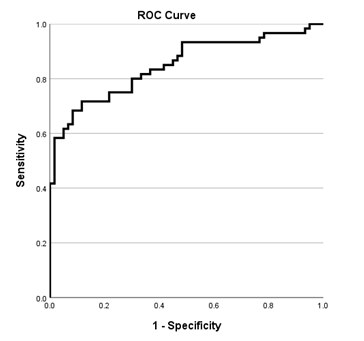Tuesday Poster Session
Category: IBD
P5328 - External Validation of the AutoIBD-UC Score in Assessing Severity of Ulcerative Colitis: A Single Center Analysis
Tuesday, October 28, 2025
10:30 AM - 4:00 PM PDT
Location: Exhibit Hall
- NH
Nicholas Hebda, MD
UMass Chan Medical School
Worcester, MA
Presenting Author(s)
Nicholas Hebda, MD1, Manisha Cole, 2, Josh Kale, 2, Safia Speer, MPH2, Abbas Rupawala, MD1
1UMass Chan Medical School, Worcester, MA; 2Virgo, San Diego, CA
Introduction: Over the last several years, artificial intelligence (AI) models have been studied and utilized with increasing frequency in various medical applications including diagnosis and evaluation of inflammatory bowel disease (IBD). One proprietary AI model, the AutoIBD-Ulcerative Colitis (UC) algorithm developed by Virgo Surgical Video Solutions (Virgo) (San Diego, CA), was designed for moderate-severe UC patient identification for clinical trial recruitment but had not previously been validated for assessing disease severity in patients with UC. We performed a single-center analysis of colonoscopy videos utilizing the AutoIBD-UC algorithm to evaluate its external validity in assessing disease severity with real-world data.
Methods: We performed a single-center retrospective analysis of patients who underwent colonoscopy between August 2023 and March 2025. A total of 60 patients with UC in various stages of severity (i.e., Mayo 0 to 3) undergoing diagnostic or surveillance colonoscopy and 60 patients without IBD (control group) undergoing screening colonoscopy were identified. Software from Virgo was utilized for cloud video capture of all colonoscopies, and videos were retrospectively segregated and analyzed using the AutoIBD-UC algorithm. Independent-sample T testing, one-way ANOVA, and receiver operating characteristic (ROC) curves were utilized for statistical analysis.
Results: AutoIBD scores were significantly different between all control patients and all UC patients (mean 0.168 versus 0.318 respectively, p < 0.001), UC patients with inactive (Mayo 0) vs active (Mayo ≥1) disease (mean 0.193 vs 0.356, p < 0.001), and UC patients with inactive-mild (Mayo 0 or 1) vs moderate-severe (Mayo 2 or 3) disease (mean 0.238 vs 0.465, p < 0.001). Using ANOVA, there was no significant difference in AutoIBD scores between UC patients with inactive vs mild disease (Mayo 0 vs 1; p=0.213) or moderate vs severe disease (Mayo 2 vs 3; p=0.309). ROC analysis indicated an area under the curve (AUC) of 0.849 for all control patients versus all UC patients [Figure 1].
Discussion: Our single-center results support the external validity of the Virgo AutoIBD-UC algorithm in assessing and stratifying disease severity in patients with UC using real-world colonoscopy data.

Figure: Figure 1. ROC Curve for AutoIBD-UC Scores Between All Control Patients Versus All UC patients
Disclosures:
Nicholas Hebda indicated no relevant financial relationships.
Manisha Cole: Virgo – Employee.
Josh Kale: Virgo – Employee.
Safia Speer: Virgo – Employee.
Abbas Rupawala: Abbvie – Consultant, Speakers Bureau. Pfizer – Consultant. Takeda – Consultant.
Nicholas Hebda, MD1, Manisha Cole, 2, Josh Kale, 2, Safia Speer, MPH2, Abbas Rupawala, MD1. P5328 - External Validation of the AutoIBD-UC Score in Assessing Severity of Ulcerative Colitis: A Single Center Analysis, ACG 2025 Annual Scientific Meeting Abstracts. Phoenix, AZ: American College of Gastroenterology.
1UMass Chan Medical School, Worcester, MA; 2Virgo, San Diego, CA
Introduction: Over the last several years, artificial intelligence (AI) models have been studied and utilized with increasing frequency in various medical applications including diagnosis and evaluation of inflammatory bowel disease (IBD). One proprietary AI model, the AutoIBD-Ulcerative Colitis (UC) algorithm developed by Virgo Surgical Video Solutions (Virgo) (San Diego, CA), was designed for moderate-severe UC patient identification for clinical trial recruitment but had not previously been validated for assessing disease severity in patients with UC. We performed a single-center analysis of colonoscopy videos utilizing the AutoIBD-UC algorithm to evaluate its external validity in assessing disease severity with real-world data.
Methods: We performed a single-center retrospective analysis of patients who underwent colonoscopy between August 2023 and March 2025. A total of 60 patients with UC in various stages of severity (i.e., Mayo 0 to 3) undergoing diagnostic or surveillance colonoscopy and 60 patients without IBD (control group) undergoing screening colonoscopy were identified. Software from Virgo was utilized for cloud video capture of all colonoscopies, and videos were retrospectively segregated and analyzed using the AutoIBD-UC algorithm. Independent-sample T testing, one-way ANOVA, and receiver operating characteristic (ROC) curves were utilized for statistical analysis.
Results: AutoIBD scores were significantly different between all control patients and all UC patients (mean 0.168 versus 0.318 respectively, p < 0.001), UC patients with inactive (Mayo 0) vs active (Mayo ≥1) disease (mean 0.193 vs 0.356, p < 0.001), and UC patients with inactive-mild (Mayo 0 or 1) vs moderate-severe (Mayo 2 or 3) disease (mean 0.238 vs 0.465, p < 0.001). Using ANOVA, there was no significant difference in AutoIBD scores between UC patients with inactive vs mild disease (Mayo 0 vs 1; p=0.213) or moderate vs severe disease (Mayo 2 vs 3; p=0.309). ROC analysis indicated an area under the curve (AUC) of 0.849 for all control patients versus all UC patients [Figure 1].
Discussion: Our single-center results support the external validity of the Virgo AutoIBD-UC algorithm in assessing and stratifying disease severity in patients with UC using real-world colonoscopy data.

Figure: Figure 1. ROC Curve for AutoIBD-UC Scores Between All Control Patients Versus All UC patients
Disclosures:
Nicholas Hebda indicated no relevant financial relationships.
Manisha Cole: Virgo – Employee.
Josh Kale: Virgo – Employee.
Safia Speer: Virgo – Employee.
Abbas Rupawala: Abbvie – Consultant, Speakers Bureau. Pfizer – Consultant. Takeda – Consultant.
Nicholas Hebda, MD1, Manisha Cole, 2, Josh Kale, 2, Safia Speer, MPH2, Abbas Rupawala, MD1. P5328 - External Validation of the AutoIBD-UC Score in Assessing Severity of Ulcerative Colitis: A Single Center Analysis, ACG 2025 Annual Scientific Meeting Abstracts. Phoenix, AZ: American College of Gastroenterology.
